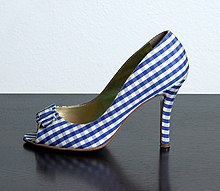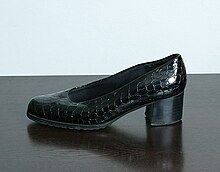pumps

The Pumps [ PÖMPS ] ( plural : the pumps) is a widely cut-out, but otherwise closed shoe without closure (no laces, straps, zippers, elastic bands or the like) with a flat sole and a mode conditionally form varying paragraph of at least 3 and at most 9, 5 centimeters high.
etymology
The word was borrowed from English into German, the further derivation is uncertain. The oldest evidence goes back to the 16th century. In Shakespeare this designation can be found in 1594; In the British and American-speaking countries, the term pumps are used to describe very different models , e.g. B. the flat ballet flats in the United Kingdom and the high heels in the United States.
history

In the course of the spread of heel shoes in Europe, pumps came in the 17th and 18th centuries. Century and were worn with white knee socks with knee breeches by male court laquerors. In the course of the French Revolution , the pumps temporarily lost their heels. Dandies wore them in the first half of the 19th century, and women used pumps in the second half of the century as a durable alternative to cloth and silk slippers and as a convenient replacement for the button ankle boots that were common at the time . With a shaft made of patent leather, the pumps established themselves as dance shoes for both sexes towards the end of the 19th century. The pumps became widespread in the first half of the 20th century. The increasingly better condition of the roads and new mobility options made wearing high heels possible in everyday life in the first place. In doing so, their property as a typical women's shoe emerged. Currently, pumps are worn as elegant everyday shoes or on special occasions. With the exception of the opera pumps for men, which are reserved for festive clothing, they are only used as women's shoes.
Varying characteristics
The material of the shoe upper can vary, mostly it is chrome-tanned and dyed calfskin or goat leather. Fine fabrics such as satin or silk are also used, as well as artificial leather. The shaft can be with or without decorations and jewelry applications. The tip of the shoe also varies from pointed to square-shaped, depending on the prevailing fashion. The shape of the heel, especially the higher heels, is also heavily dependent on fashion.
In the 1980s, when women and men increasingly needed appropriate business clothing, shoe manufacturers reacted and brought many elegant and comfortable pumps with wider toe caps and moderately high heels of three to five centimeters on the market.
Shoe model group Pumps

Many modifications of the basic shape of the pump have emerged over the decades, so that a shoe model group name Pumps has now emerged. However, it is debatable to what extent some of these variants can still be called pumps .
-
Heeled shoe (also stiletto )
In the 1950s, pumps with a very pointed toe and stiletto heel were modern: the high-heeled shoe . The shoe is also called stiletto because of its heel , this is the Italian name for the pencil heel , see the article about the shoe heel .
-
High-front pumps
A very high-cut shoe that is closed to the instep, otherwise similar to a pump, is called a high-necked or high- front pump .
-
Peeptoes
Models with a small opening at the tip of the shoe are called peep toes as long as the toes are only vaguely visible. As long as they don't have platform soles or extremely high heels, they belong to the group of pumps.
-
Opentoes Open toe
at the toe so that the toes are freely visible are called open toes.
-
Flamencopumps
Mostly closed toe and different heel shapes, but almost always with ankle straps, sometimes also / or with clasp over the instep (but not to be confused with Mary Janes).
-
Lace-up pumps
Higher cut, sportier- looking pumps (additional upper parts, conspicuous seams) with a non-functional instep lacing (one or two pairs of eyes).
-
Opera
pumps Pumps as men's shoes in court fashion of the 18th century have survived to this day in the form of so-called opera pumps , as a classic evening shoe (with a black upper made of smooth or patent leather, and with a flat heel and a grosgrain silk bow on the front sheet) with a tuxedo and tailcoat .
Definition of terms
Above all, shoes that have a clasp (strap with clasp) - wherever it is placed - do not count - from a shoe- technical point of view - to the model group of pumps , but to clasp shoes , even if there are terms like "clasp pumps", "ankle strap pumps" etc. gives. The following models also do not fall into the group of pumps:
-
SLINGBACKS or Riemchenpumps
The shaft of sling backs (colloquially Riemchenpumps ) is in the range of the hindfoot into a closure strap, thereby resulting in an open heel. (Pumps, on the other hand, generally have a closed shaft and no closure)
-
High heels High-heeled
shoes with a heel height of around 10 cm or more are called high heels regardless of the shaft cut. There are various model variants of these shoe models, including shoes that show the shaft cut of a pump, but still belong to the shoe model group of high heels .
Others
In 2014, an exhibition entitled “Footwear” was opened in the German Leather Museum in the “ Leather City” of Offenbach am Main ; she showed u. a. a few dozen women's shoe models by the shoe designer Roger Vivier, who died in 1998 (who is famous in his home country France and America, but not in Germany). Vivier is considered to be the inventor of the stiletto, comma and choc paragraph.
At the Cannes Film Festival in May 2015, women complained that they were warned on the red carpet to wear high heels.
Individual evidence
- ↑ OED Online , s. v. pump, n.2 . Oxford University Press, 2008.
- ↑ Shakespeare: Taming of the Shrew (1594), 4th act, 1st scene, says Grumio: "Nathaniel's coat, sir, was not fully made, And Gabr'el's pumps were all unpink'd i 'th' heel". Also in 1595 in Midsummeright's Dream , 4th act, 2nd scene, bottom: “Get your apparel together, good strings to your beards, new ribands to your pumps; meet presently at the palace ".
- ↑ see also English Wikipedia
- ↑ FAZ.net March 24, 2014: Exhibition "Schuhwerke"
- ↑ www.ledermuseum.de ( Memento from March 29, 2014 in the Internet Archive ), exhibition until November 2, 2014
- ↑ Festival director rows back, indignation over the requirement for high heels , ORF.at, May 20, 2015. Accessed May 20, 2015.
Web links
literature
- Linda O'Keeffe: Shoes: A tribute to sandals, slippers, high heels . Ullmann, Potsdam 2013, ISBN 978-3-8480-0605-2 .


